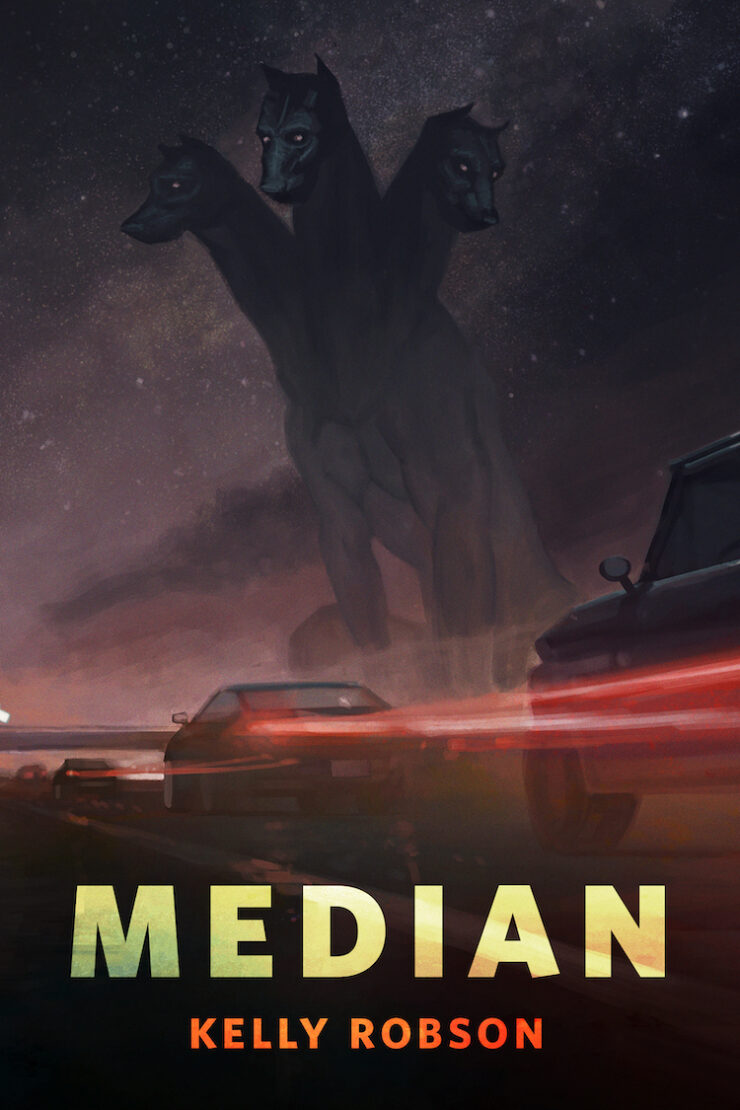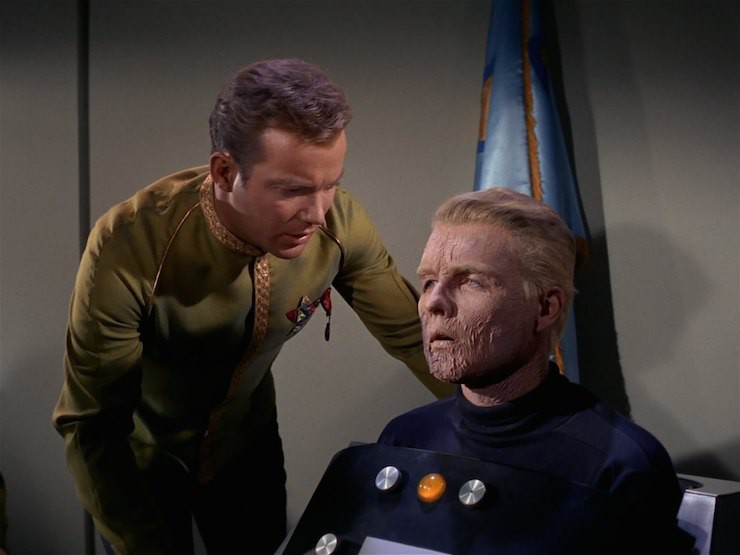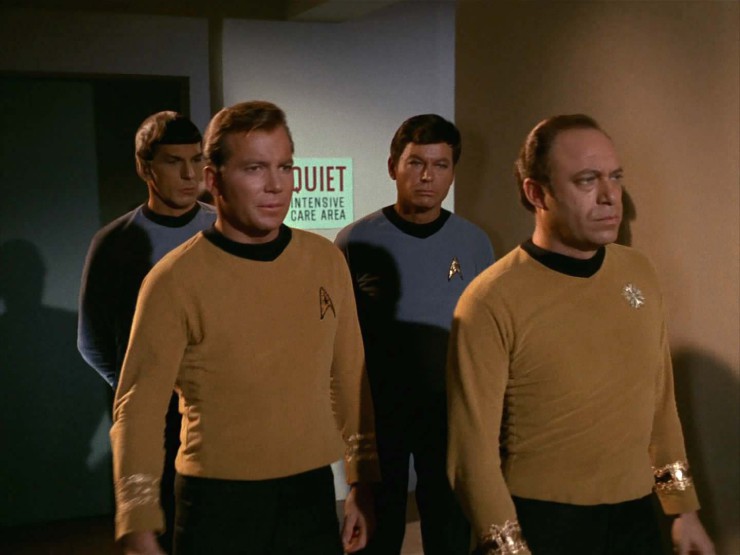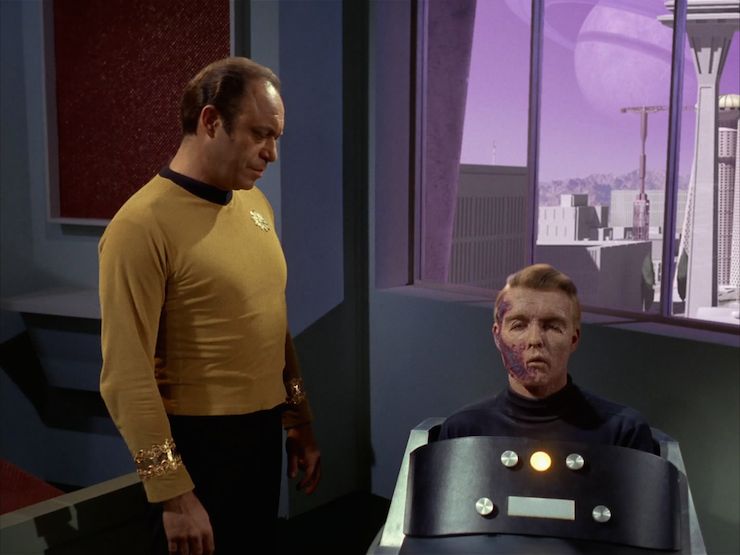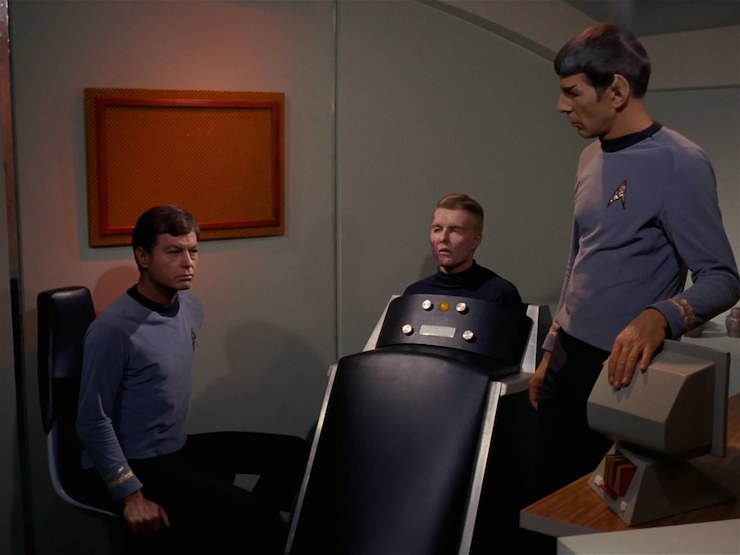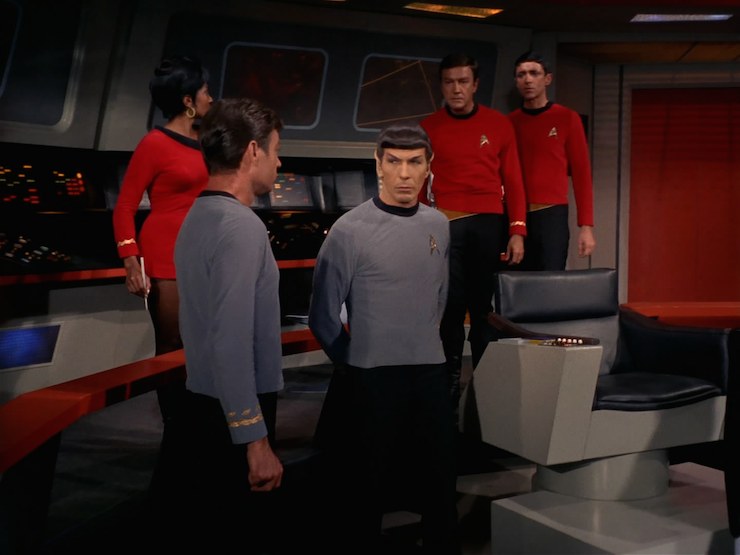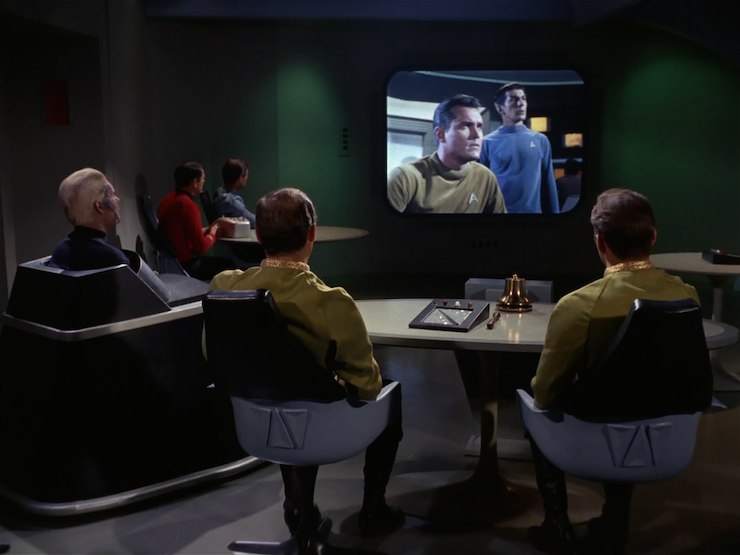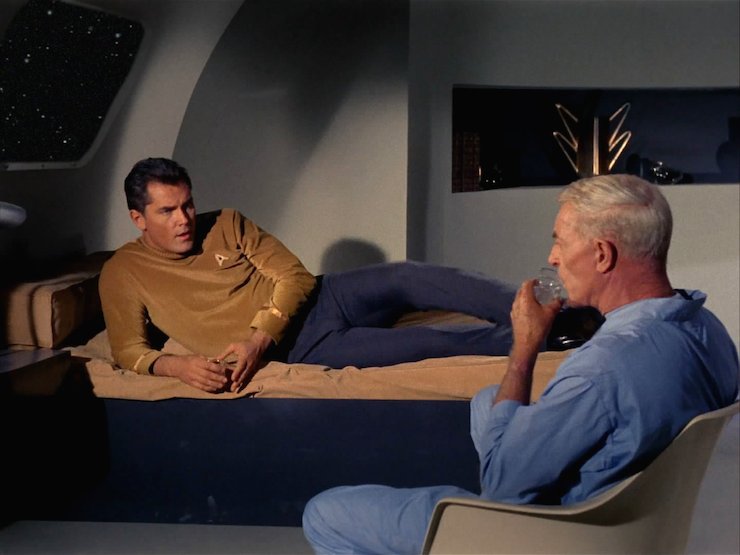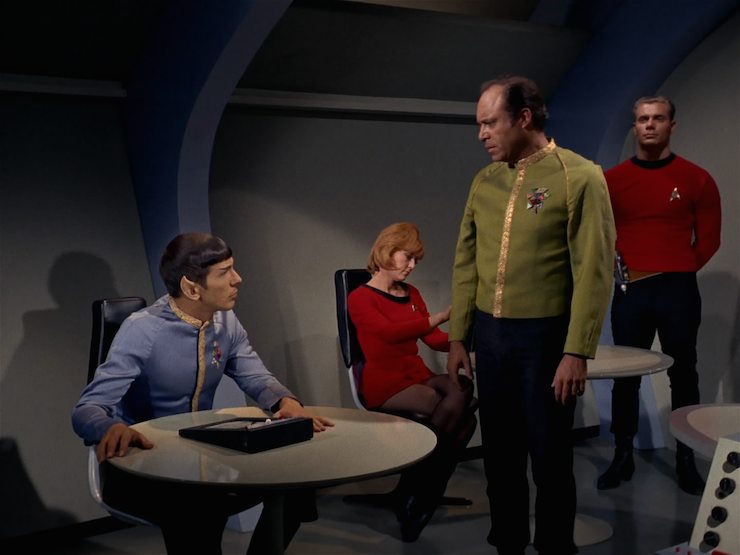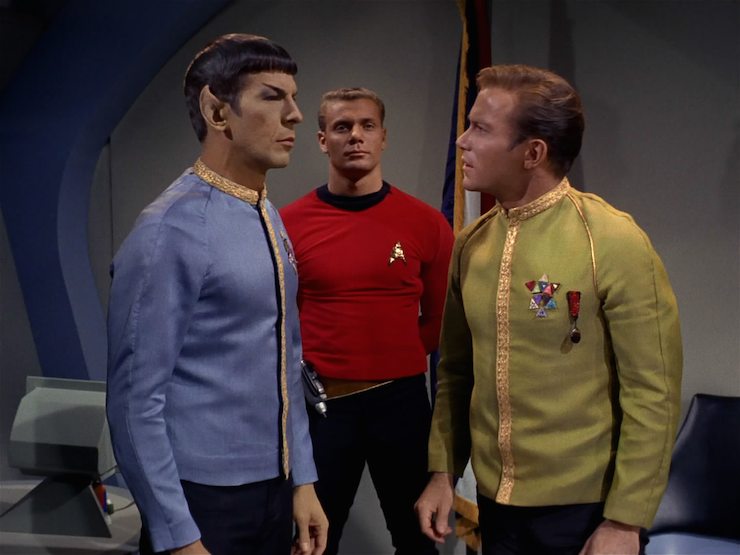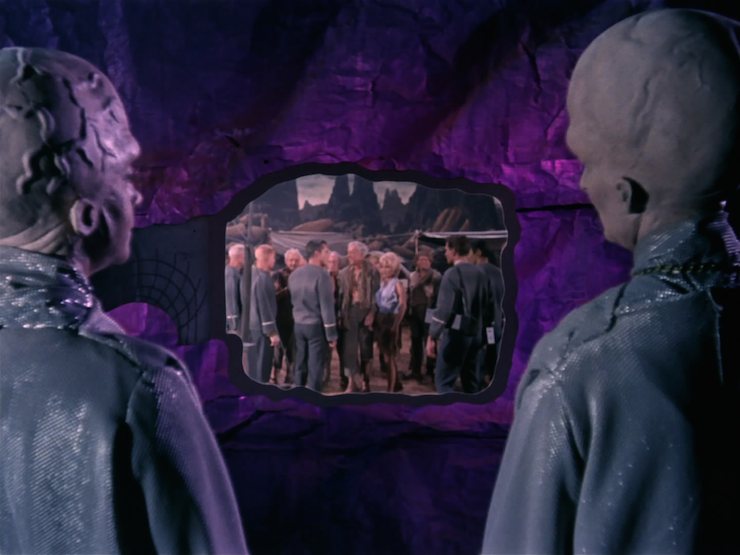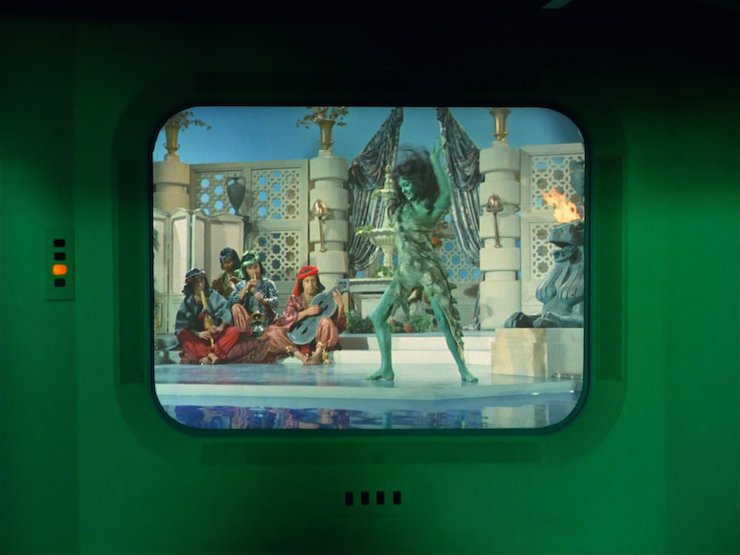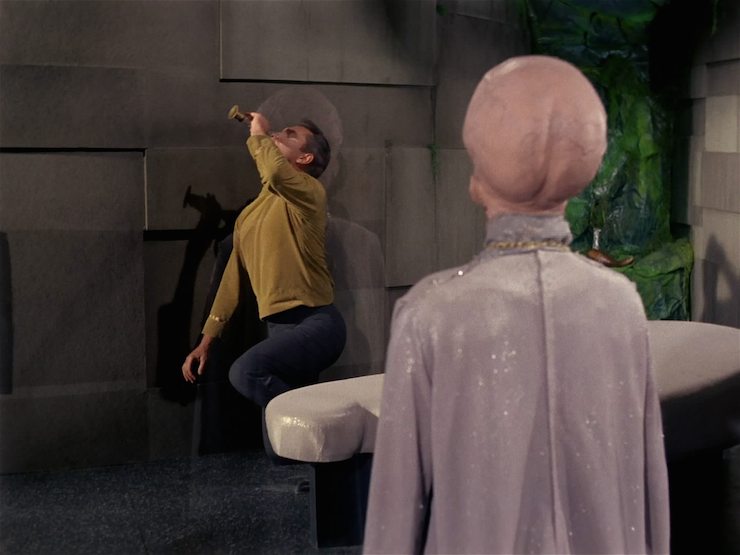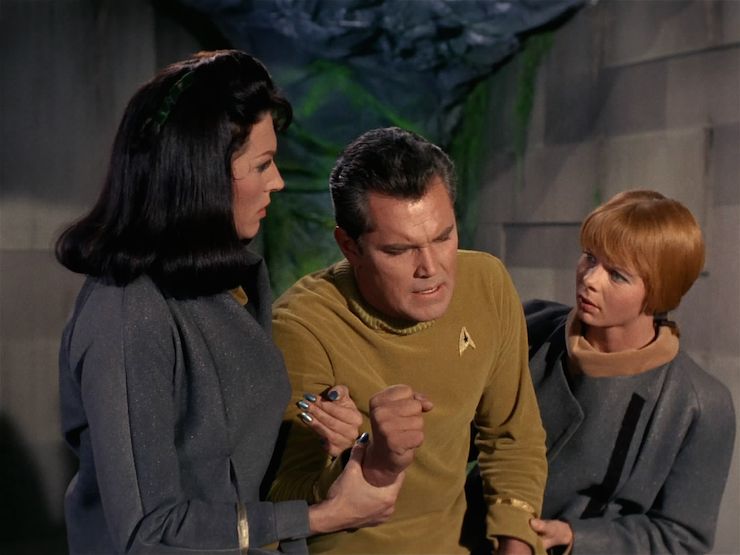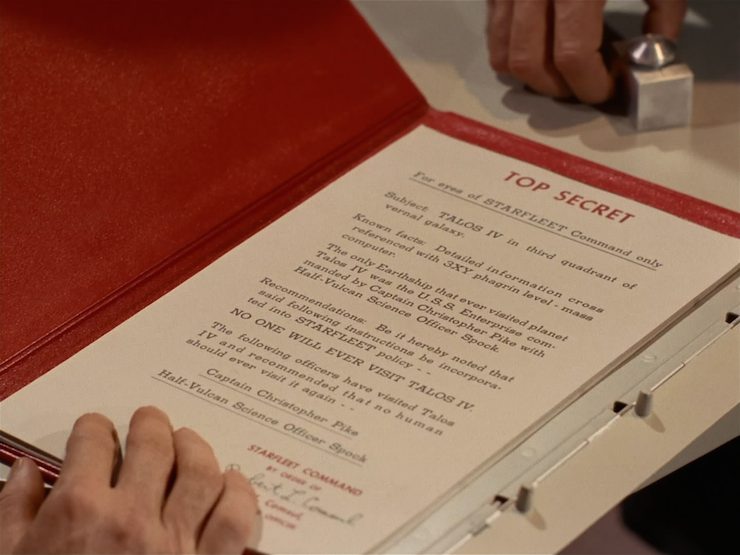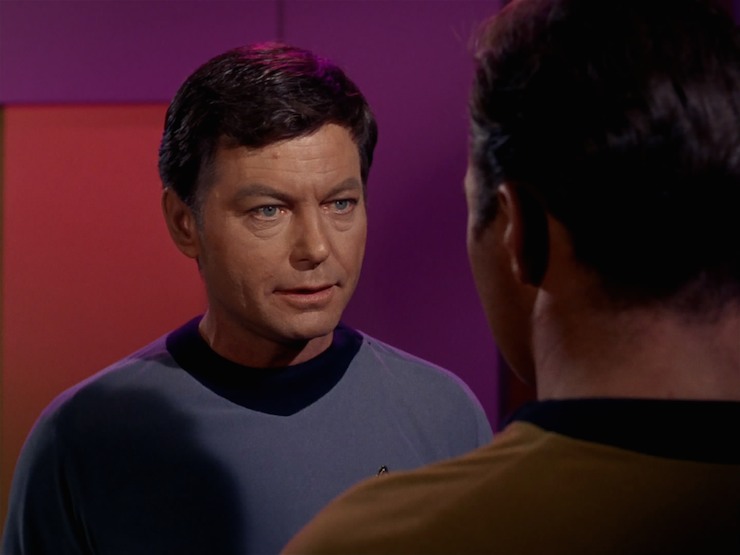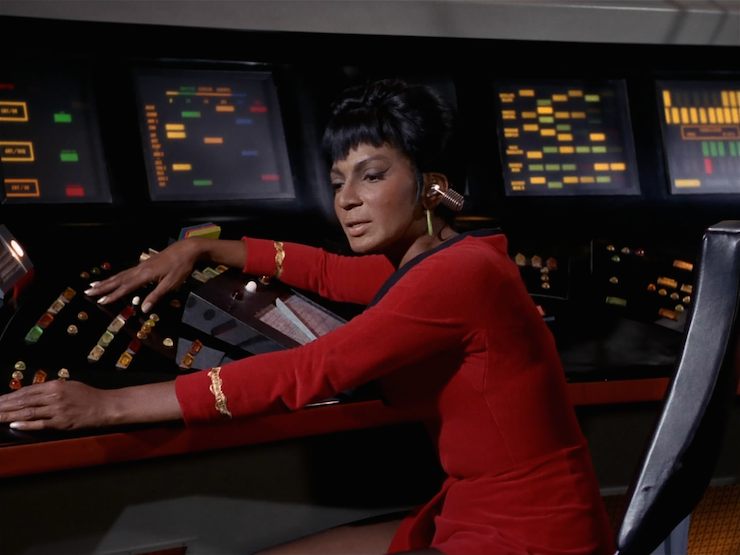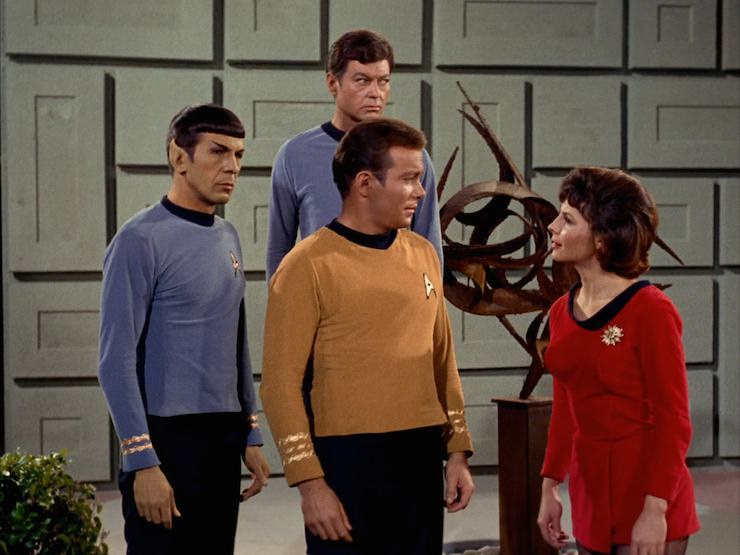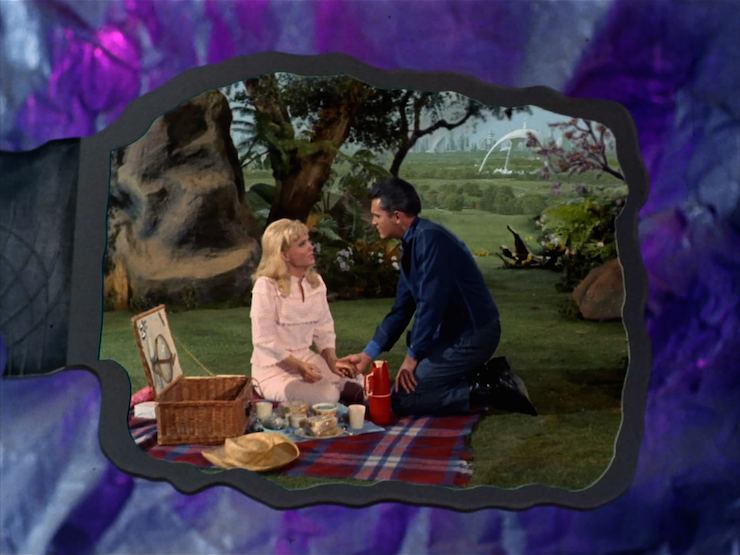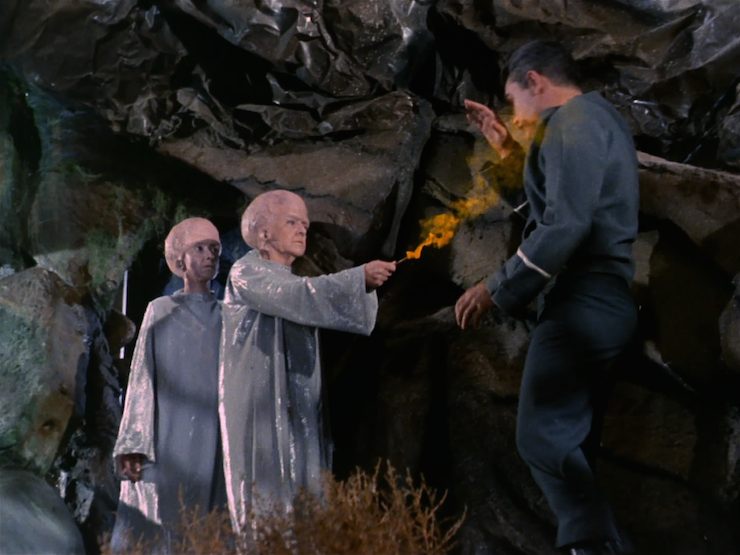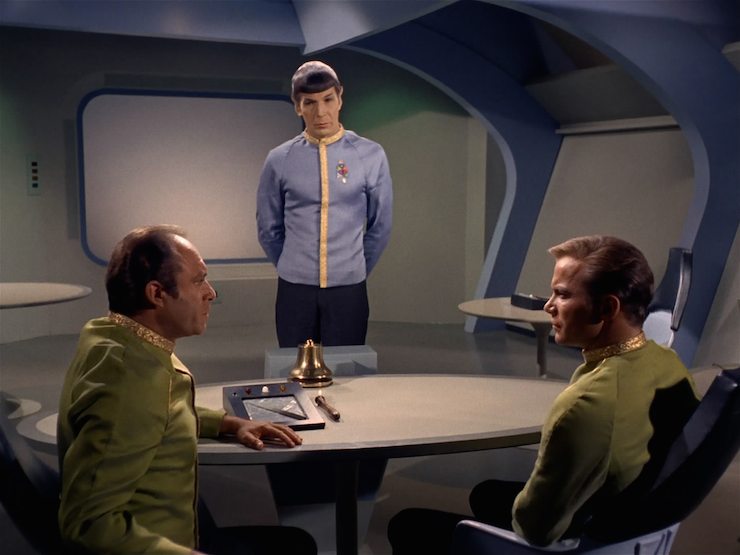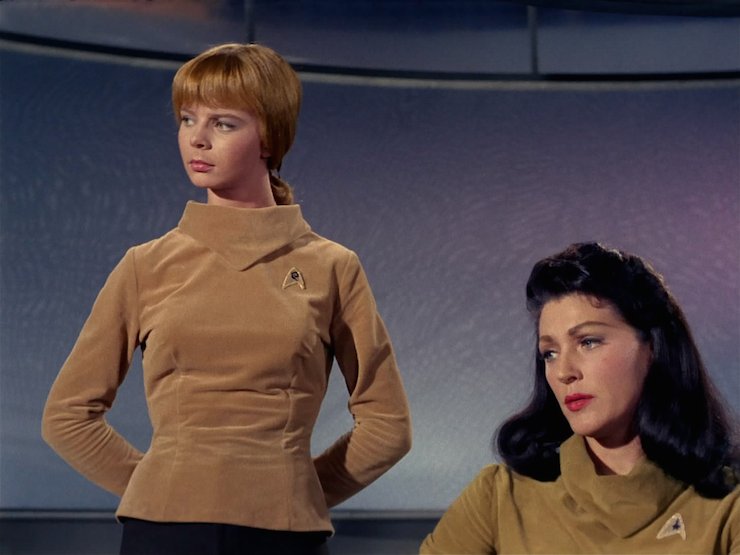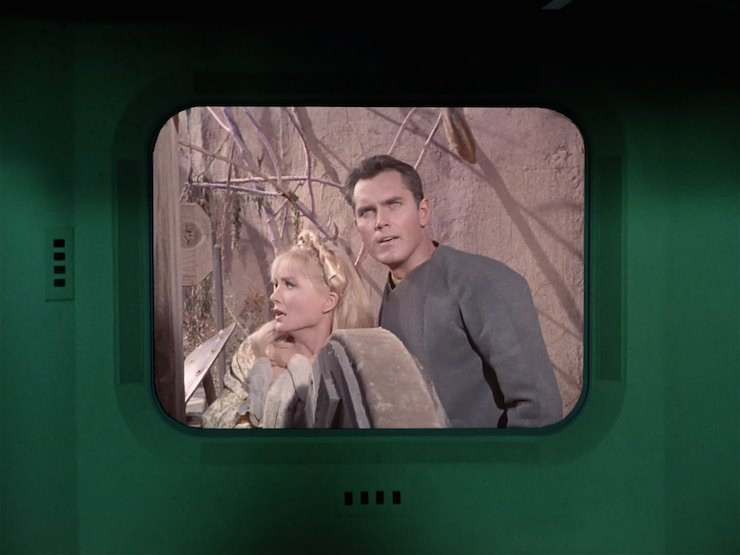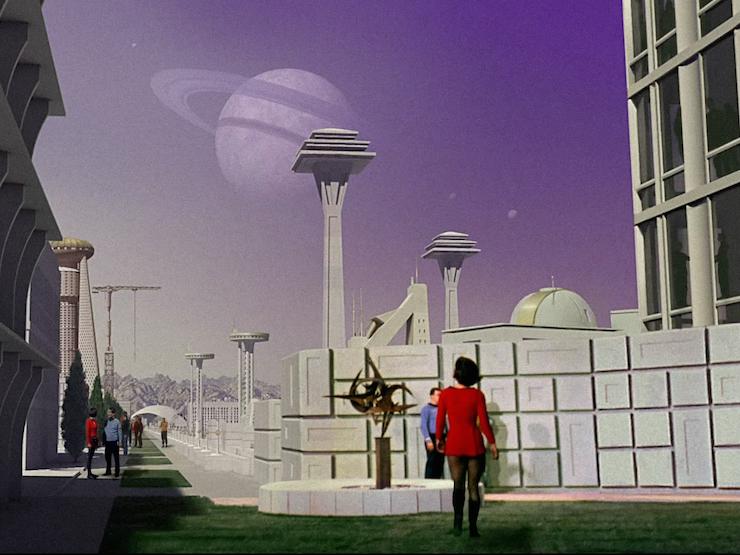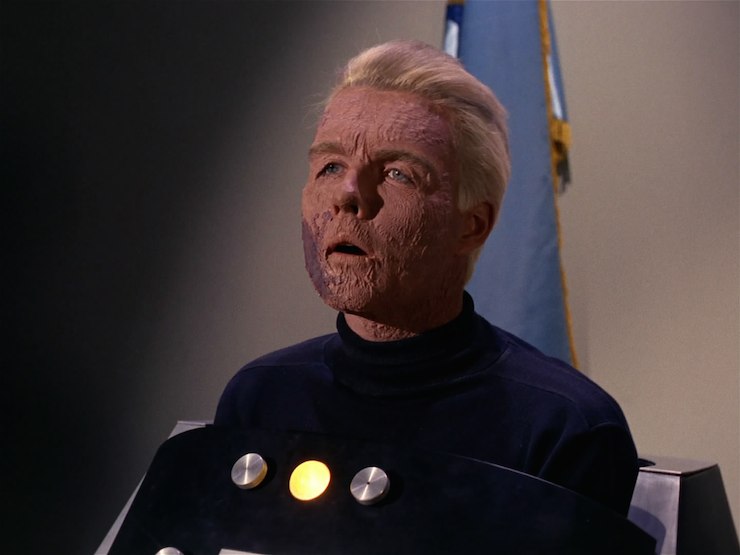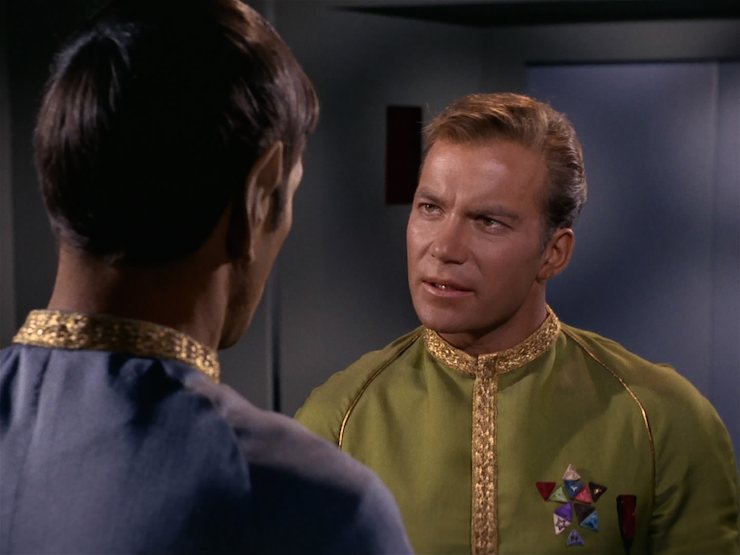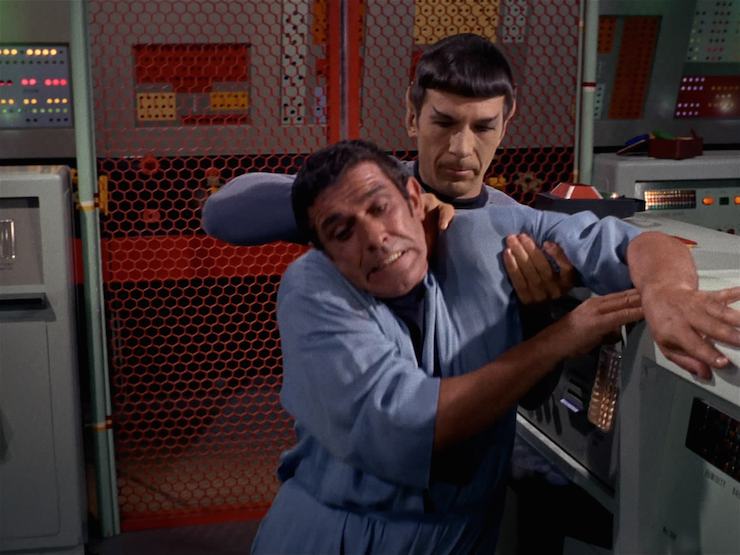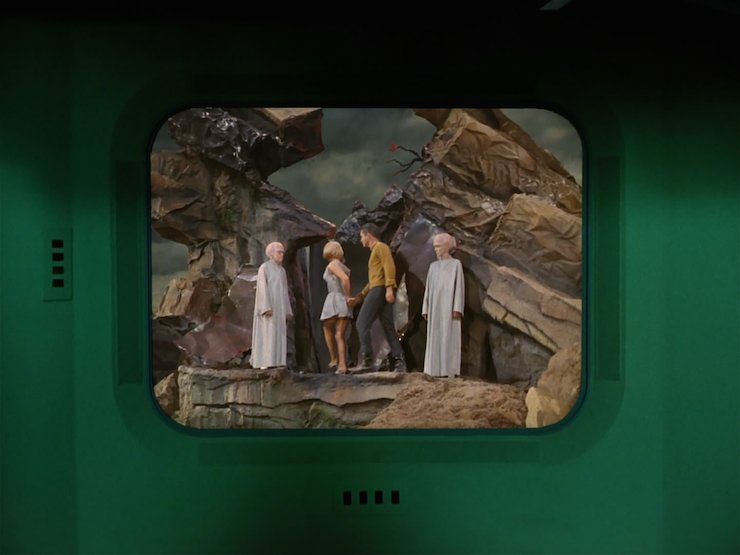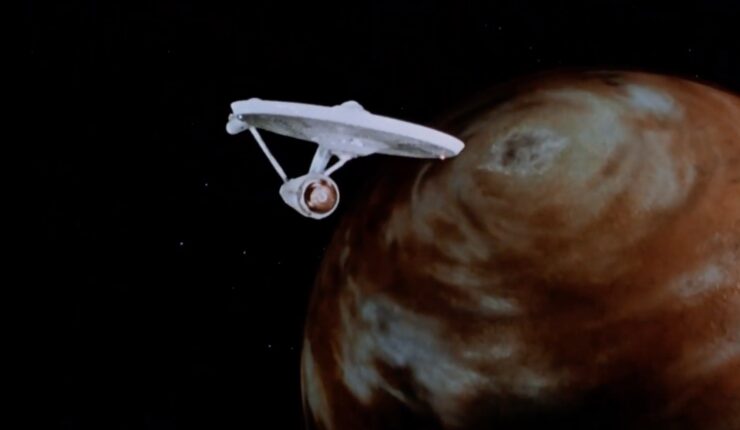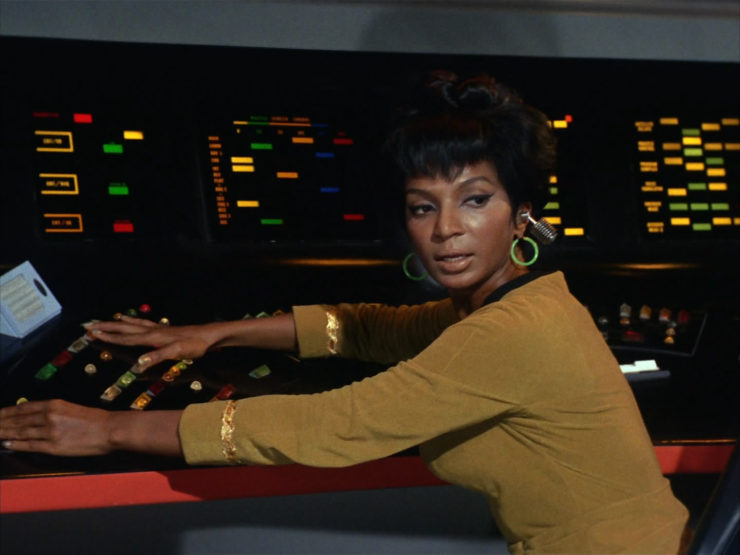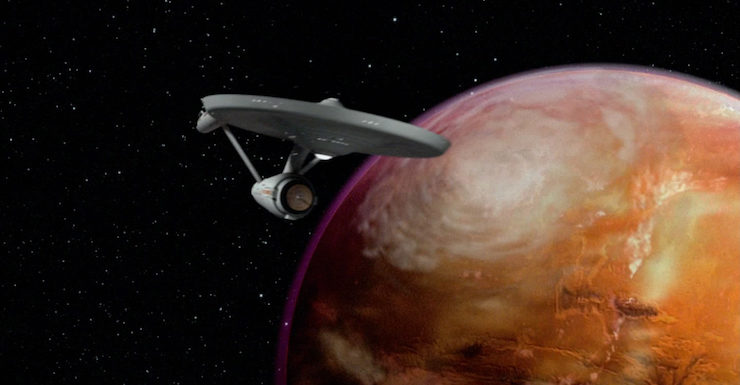“The Menagerie” Parts 1 & 2
Written by Gene Roddenberry
Directed by Marc Daniels (framing sequence) and Robert Butler (flashbacks)
Season 1, Episodes 15 & 16
Production episode 6149-16A & 6149-16B
Original air date: November 17 & 24, 1966
Stardate: 3012.4
Captain’s log. The Enterprise received a subspace message to report to Starbase 11, but when Kirk, Spock, and McCoy beam down, Lieutenant Piper says no such message was sent by the starbase. They meet with Commodore Mendez, telling him that Spock received a message from the former commander of the Enterprise, Fleet Captain Christopher Pike. Mendez assures Kirk that that’s impossible. Pike was injured while rescuing cadets on an old Class-J ship where the baffle plate ruptured. The delta rays injured him sufficiently that he’s wheelchair bound, paralyzed, unable to speak. All he can do is indicate yes or no by making his wheelchair beep.
Mendez takes the trio to see Pike, but he doesn’t want company. He does make an exception for Spock, who served under Pike for over eleven years. When they’re alone, Spock says he has a plan to help him. Pike keeps saying no, but Spock insists, even though he knows it’s mutiny and treason.
Kirk and Mendez go over the starbase records, but there’s absolutely no record of any kind of transmission from the base to the Enterprise. Kirk doesn’t believe Spock would lie, especially since he would’ve granted leave to see Pike if Spock had asked for it. And Pike couldn’t possibly have sent the message or even asked for it to be sent.
Spock goes to the computer room and fakes a signal to the Enterprise from Starbase Operations that the ship’s new orders are top secret, being fed directly into the computer, the destination scrambled, the helm to be handled by the computer. Spock orders Hansen, currently in charge of the ship, to not discuss this mission with anyone, not the crew, not starbase personnel.
Kirk observes Pike, who keeps saying “no.” He and McCoy try to figure out what’s going on. Spock is the obvious suspect, but it’s unthinkable that it would be him. McCoy is summoned to the Enterprise for a medical emergency. Mendez shows Kirk the file on Talos IV. It’s a quarantined planet, and going there is punished by the death penalty. The one ship that has visited Talos IV is the Enterprise, under the command of Pike, whose science officer was Spock. But even the sealed Starfleet report doesn’t say why or what there is on Talos IV.
Suddenly, Pike disappears and the Enterprise warps out of orbit. Spock has transported Pike to the ship, faked instructions from Kirk for McCoy to take care of Pike but not question him, and told the crew that he’s in command per Kirk’s orders on their top secret mission from the starbase.
Hansen detects a shuttlecraft following them, but Spock orders Uhura to maintain radio silence and Hansen to maintain course and speed. Mendez and Kirk are on the shuttle and they keep trying to contact the ship, but with no answer.
Spock determines that the shuttlecraft is past the point of safe return to the starbase, at which point he orders the computer to reverse engines and take the shuttle in tow. He then orders security to the bridge, the transporter room to prepare to beam the captain aboard, puts Hansen in command, and then submits himself to McCoy, as the highest-ranking officer, for arrest for mutiny.
Scotty beams Kirk and Mendez aboard and Hansen turns command back to Kirk, reporting that Spock is confined to quarters. However, the ship is still under computer control, and the computer won’t relinquish it, not even to Kirk, until they reach Talos IV.
Mendez and Kirk hold a hearing to determine whether or not a court martial should be called. Spock waives his right to counsel—and also to the hearing. He wants the court martial. Kirk points out that there needs to be three command officers on the trial board, and there’s only him and Mendez—but there’s also Pike, who hasn’t been retired and is still considered active.
The court martial is convened. Mendez asks why it’s so important to take Pike to Talos IV. By asking that question, Spock has the right to present evidence that would answer the question. He asks that the monitor screen be put on, and they start to watch “The Cage“…
Kirk is confused. Pike acknowledges that what they see is what happened, but no record tapes were ever made at that level of detail. Spock won’t say where the images are coming from, and Mendez refuses to watch them, but Kirk protests, saying he wants to see the rest.
They see as Pike refuses to investigate the distress call without evidence of survivors, talking with Boyce in his quarters, getting a subsequent distress call, and travelling to Talos.
Mendez orders the screen off. This is a court, not a theatre, and he accuses Spock of manufacturing it. Pike, however, confirms that the footage is real. Mendez votes to discontinue the viewing, but Kirk and Pike both vote to continue.
They watch as the Enterprise arrives at Talos IV and beams down to meet the Columbia survivors and Vina. Vina leads Pike to the underground cavern and the rest of the landing party watches helplessly as Pike is kidnapped by the Talosians and the Columbia survivors disappear.
After Spock reports to Number One, they turn the monitor off when Uhura calls from the bridge. Starbase 11 has discovered that the Enterprise is receiving transmissions from Talos IV, in direct violation of Starfleet General Orders. Kirk is relieved of command and Mendez put in charge. The commodore orders Spock to return the ship to manual control, an order he disobeys. (He’s already on trial for the death penalty, so what’s another mutiny between friends?)
Mendez declares a recess. Kirk asks if Spock has gone nuts, but he insists that the rest of the transmission be viewed—just in time for the end of Part 1.
Part 2 commences with an almost theatrical re-creation of some of the events of Part 1, plus a quickie summary of the footage we’ve seen so far from “The Cage,” and then the teaser ends with an abbreviated version of the end of Part 1. Cha cha cha.
After the credits, Spock explains that the Keeper on Talos IV has taken control of the ship. Pike beeps his understanding, and the screen goes back on. The court martial is now a closed session: only the board and Spock are present. We see Pike’s introduction to the Talosians, the meeting Number One holds with the senior staff to discuss options, and then we have the Talosians’ first bond-with-Vina scenario: a re-creation of the battle they just finished on Rigel VII.
Seeing the images starts to take its toll on the crippled Pike. The Talosians pause the transmission so he can recover long enough for NBC to do a commercial break, then they pick up with Pike questioning Vina in the cell while Vina tries (and fails) to get him to play along. On the surface, Number One fires a big-ass laser cannon at the cavern entrance. After the Talosians take Vina away, the Keeper feeds Pike, showing him an example of torture. The Keeper confirms to Pike (and Spock confirms to Kirk and Mendez) that Vina is a human, the only survivor of the Columbia crash.
Next, Pike and Vina have their picnic in Mojave, and Vina admits that the Talosians can’t handle primitive emotions, but it’s not something you can maintain. They also both admit that they’re attracted to each other, not just because the Talosians forced them into it. That’s followed by everyone’s favorite, the Orion dancing girl bit! (We also cut to the trial, and Kirk is obviously transfixed by the hot green chick on the monitor screen.)
A landing party tries to beam down, but only Number One and Colt successfully transport (prompting Spock’s classic, plaintive cry of, “THE WOMEN!”). The Keeper goes on about how awesome the two new women would be as potential mates. Later, Pike kidnaps the Keeper and uses the Talosian as a hostage to get to the surface.
Then the transmission just stops. Mendez calls for a vote. All three members of the trial board declare Spock to be guilty as charged so they can have a dramatic beat to go to commercial on. After the commercial, the Enterprise enters orbit of Talos IV, and Spock explains that the Talosians have control of the ship, and then the transmissions proceed as if they were never interrupted and the board never voted.
Number One sets a laser to overload rather than allow them all to become prisoners of the Talosians. But then the Talosians finish going over the Enterprise records, realizing that humans really really hate captivity a whole bunch, so the Talosians let the crew go, showing that Vina is too deformed to go with them.
The Enterprise pootles out of orbit, and the transmission ends—and then Mendez disappears as well. The Keeper speaks to Kirk telepathically, explaining that the commodore was an illusion, and Mendez never truly left Starbase 11. The court martial was a handy distraction to keep Kirk from regaining control of the ship too quickly. Uhura then relays a message from Starbase 11, which also received the transmissions from Talos IV. General Order 7 is rescinded on this occasion in light of Pike’s huge contributions to space exploration. Pike beeps yes when Kirk asks if he wants to go to Talos, and he orders Spock to escort him to the transporter room.
The Talosians show Kirk the illusory versions of Pike and Vina going off together to live happily ever after.
Fascinating. Spock is found guilty of violating General Order #7, which carries the death penalty, not to mention the whole thing where he steals the ship, fakes orders, and kidnaps Pike. But since one third of the trial board isn’t real, it obviously doesn’t take. And ultimately he’s trying to help out his former captain, who’s in a horrid state. Still, even with GO7 rescinded, there are also apparently no consequences for all the fraudulent stuff he did in service of getting Pike to Talos, which should get his ass drummed right out of the service…
Also, the report Mendez shows Kirk on Talos IV was signed by “Captain Christopher Pike” and “Half-Vulcan Science Officer Spock.” Yes, that’s how he’s officially listed in the report! (One assumes that, had the first officer signed it, it would’ve been “Female Lieutenant Number One,” and if the navigator did, it would’ve been, “Partly Latino Navigator Jose Tyler.”)
I’m a doctor not an escalator. McCoy is a staunch defender of Spock’s honor, which makes it even more hilarious that he actually did everything McCoy said he’s not capable of. Oops. Also Part 2 is one of only three non-pilot episodes McCoy doesn’t appear in (the others being “What Are Little Girls Made Of?” and “Errand of Mercy”).
I cannot change the laws of physics! When it’s revealed that Kirk can’t regain control of the ship, Scotty makes a wonderful snarly noise and leaves the transporter room in a huff to try to get control back.
Hailing frequencies open. Uhura relays the starbase’s instructions, whether the fake ones created by Spock, the illusory ones regarding Mendez, and the real one at the very end.
No sex, please, we’re Starfleet. We get yet another woman from Kirk’s past, as Piper mentions a “mutual friend” named Helen Johansen, the mere mention of whom makes Kirk apprehensive.
Channel open. “Don’t stop me. Don’t let him stop me. It’s your career and Captain Pike’s life. You must see the rest of the transmission.”
Spock urging Kirk to let the Talosians’ DVD of “The Cage” continue to be shown.
Welcome aboard. We’ve got recurring regulars DeForest Kelley, James Doohan, and Nichelle Nichols, along with Hagan Beggs, back again after “Court Martial” as Hansen. Kelley and Doohan are only in Part 1.
Pike is played by Jeffrey Hunter in the footage, while Sean Kenney plays the injured Pike. Majel Barrett (credited as M. Leigh Hudec), William Blackburn, Mike Dugan, Peter Duryea, Laurel Goodwin, Clegg Hoyt, John Hoyt, Anthony Jochim, Jon Lormer, Edward Madden, Leonard Mudie, Susan Oliver, and Adam Roarke are also seen in the footage from “The Cage,” though only Hunter, Barrett, Duryea, Goodwin (in Part 2 only), John Hoyt, Oliver, and Roarke are credited.
Malachi Throne has an odd dual role here. In the framing sequence, he plays Mendez, while he provided the voice of the Keeper (physically played by Meg Wyllie) in the flashbacks. To avoid confusion, his voice was electronically modified in “The Menagerie.” Julie Parrish (Piper) and George Sawaya (Humboldt) play other Starbase 11 personnel in Part 1.
Kenney will be seen again (with less makeup) as DePaul in “Arena” and “A Taste of Armageddon.” Sawaya will be seen again (with more makeup) as Klingons in “Errand of Mercy” and “Day of the Dove.” Throne will return on TNG as Pardek in the “Unification” two-parter.
Trivial matters: Producer Robert H. Justman asked for this episode to be done because they needed time to commission more scripts, and without doing this, they’d need to halt production. (It also saved some money.) So it incorporated footage from the never-aired first pilot. Because there were so many changes in how the technology worked—notably the much more laborious processes for going to warp speed and transporting—and because of the change in Spock’s personality, it was decided to have the events of “The Cage” take place thirteen years earlier than the current season.
Gene Roddenberry originally approached Robert Butler to direct the framing sequence, since he directed “The Cage,” but he wasn’t interested, so Marc Daniels was brought in. Daniels was credited with directing Part 1 while Butler was credited for Part 2. The production crew credits were similarly split, with the framing sequence crew listed at the end of Part 1 and the crew from “The Cage” listed at the end of Part 2.
The original framing sequence was written by John D.F. Black, but Roddenberry was unhappy with his work and completely rewrote it, keeping sole credit. Black filed a grievance with the Writers Guild, but they found in favor of Roddenberry.
This two-parter won the Hugo Award for Best Dramatic Presentation in 1967. It was the first of four such Hugos for Star Trek (two for TOS, two for TNG). “The Corbomite Maneuver” and “The Naked Time” were also nominated in the same category, along with the movies Fantastic Voyage and Farenheit 451. The awards were given at the World Science Fiction Convention in New York that year, and Harlan Ellison—writer of “City on the Edge of Forever,” which would win the same award a year later—was the toastmaster of the awards ceremony.
For a time, the only color footage of “The Cage” available was what came from this episode, and the early VHS releases of “The Cage” mixed black and white with color footage until a color print was located.
Malachi Throne was up for the role of Boyce in “The Cage,” but he didn’t want to be the third lead; he wanted to play Spock, but Leonard Nimoy was already contracted by that point. He accepted the role of the voice of the Keeper instead.
Filming this as a two-parter in the series scotched Roddenberry’s hoped-for plan to release “The Cage” as a movie.
This is the second time the Enterprise has visited Starbase 11, only this time Mendez is in charge. It’s possible that both commodores are part of the command structure: Stone wore operations red and was in charge of the repair schedule for ships at the base (he even had a chart in his office), while Mendez wore command gold.
Several prose and comics stories have taken place in and around the framing sequence, including the short story “A Private Anecdote” by Landon Cary Dalton in Strange New Worlds, the comic book Captain’s Log: Pike by Stuart Moore & JK Woodward (which dramatizes the accident that crippled Pike), and the novel Burning Dreams by Margaret Wander Bonanno.
The remastered version released in 2006 named the shuttlecraft Kirk and Mendez took from Starbase 11 to the Enterprise as the Picasso. The two-parter was shown in a limited theatrical release in November 2007, as a promotion for the impending release of the remastered editions of the second season.
Some works of tie-in fiction have had people other than Spock serving under both Pike and Kirk, most notably Vulcan’s Glory by D.C. Fontana positing that Scotty was on board as a junior engineer during the Talos mission, but this very episode makes that unlikely if not impossible, since Scotty is right there in the early parts of the court martial before the revelation that the transmissions are coming from Talos IV, leading to it becoming a closed session. If Scotty had been on that mission, it would’ve come up in the episode—and, for that matter, he wouldn’t have needed to be excluded from the court martial, since he was there…
Your humble rewatcher had the great pleasure of meeting Sean Kenney, who played the injured Pike, at Treklanta this past spring, where we were both guests. Kenney wrote an autobiography called Captain Pike Found Alive! which is partly about his experiences filming this two-parter.
To boldly go. “Spock would have some logical reason for going there.” This is an iconic episode, with good reason. The image of Pike in the wheelchair is one that has become seared on popular culture, not to mention the fact that—until the VHS release of “The Cage” in 1986—this two-parter was the only way to see the original pilot. It’s an interesting episode for the same reason that “The Cage” is, as a look at what Star Trek might have been. Better still, it edits down “The Cage,” and all the cuts are good ones, either scenes that the story can live without (Spock trying and failing to leave orbit) or that are actively offensive (all of Pike’s “I don’t like having women on the bridge” lines, to which I say good riddance).
Unfortunately, the framing sequence around it is just horrible. It’s impressive to see Spock willing to throw his life and career away out of loyalty to Pike, but it would’ve been more impressive if any of his actions had any consequences. Or, better yet, if he’d just asked Kirk for help, something Kirk himself said at the end. As it is, he’s committed several crimes, and even plead guilty to them, and the only one that he’s actually let off the hook for is violating General Order #7. He still forged orders, lied to his commanding officer, assaulted two fellow Starfleet officers (the two guys he nerve-pinched in Starbase Operations in Part 1), impersonated a captain, hijacked the Enterprise, and kidnapped Pike.
The framing sequence is a desperate attempt to create suspense, which is the only reason why Roddenberry whips out the big gun of the death penalty: Look, Spock’s putting his life on the line! But, seriously, the death penalty for going to a planet full of powerful telepaths? That’s a bit of an overreaction, especially since the Talosians are obviously capable of tricking people into coming to their world (that’s kind of how the whole thing got started).
Perhaps hyper-aware of the infamous “too cerebral” note he got from NBC, Roddenberry’s framing script also constantly interrupts the action of the footage from “The Cage” so Kirk, Mendez, and Spock can provided clunky exposition to explain the storyline. It’s at least partly to give the main characters and main guest star more lines, but it feels like he’s insulting the audience’s intelligence.
Leonard Nimoy does excellent, efficient work as a saboteur and mutineer, reminding us just how impressive Spock is, and also showing the deep reserves of loyalty and friendship without losing the character’s calm and logic. DeForest Kelley does a great job going from defending Spock to Kirk to being so totally gobsmacked when Spock submits himself for arrest, and Malachi Throne is simply superb as Mendez. But overall, the framing sequence is dumber than a bag of hair, redeemed only by the flashbacks that it frames. I’d give the frame a 2, and since I already gave “The Cage” a 6, that makes it easy to give the episode this rating…
Warp factor rating: 4
Next week: “Shore Leave”
Keith R.A. DeCandido wasn’t the bullet that laid him to rest, it was the low spark of high-heeled boys.





